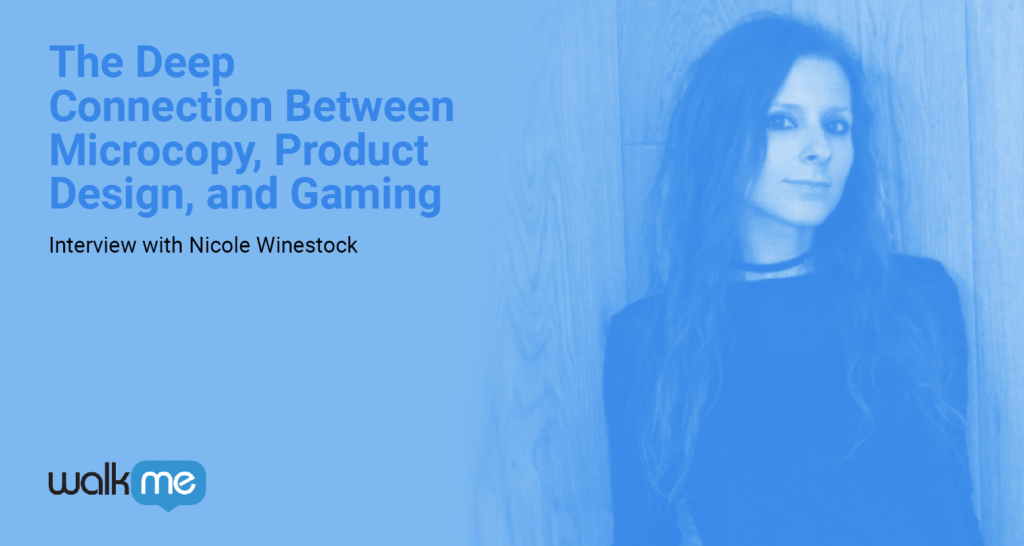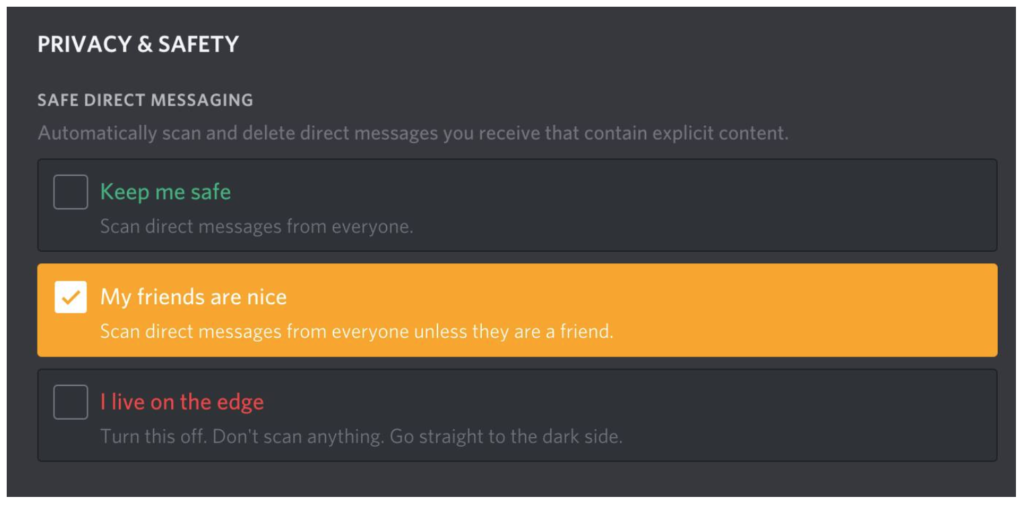
Hey There! My name is Nicole Winestock and I’m a Senior UX Designer (though I prefer the term UX unicorn! ?).
For the past 3 years, I’ve been working for WalkMe, which is a B2B SaaS company. My mission is to make the world user-friendly.
My darkest secret is that I used to sing in high-school ceremonies all the time. I also tried to learn to play the guitar because I wanted to be a musician. I gave up that dream because I didn’t think I’m that good of a singer and I was a terrible guitar player…
In one single word, what does microcopy mean to you?
Humanity

How did you get into UX design?
I’ve landed my first UI design gig nearly 5-6 years ago when I started working for an advertising company called Gitam BBDO. That was more or less design school for me, I learned how to work with different departments and teams and how to design using both my heart and brain.
But it wasn’t enough, I was missing project continuation and I was also starting to pick up basic UX principles without even knowing it.
Soon enough I started learning stuff online by reading articles and researches and I realized this was my niche.
WalkMe’s director of UX saw the potential in me and decided to add me to the team.
Tell me about your process as a Senior UX designer at Walk Me?
First and foremost I want to understand the situation. If our users are facing a problem I want to know what it is and why it is, if we’re requested to add a new feature I want to understand the requirements and the expected value.
That’s when I deep dive into research, talking to users always help you get a clear image.
After a bit of market and competitors research, the Product Manager and I would start writing down the requirements and the suggested solutions. I usually go for at least 3 concepts of the solution (on paper).
You should always sketch as many as you can, even if you don’t believe in one of the concepts, it will help you strengthen your other solutions and convince others why some ideas are better than others.
Once we decided on the solution and sit with Dev to be aligned UX and Dev wise we start the initial wireframing process and eventually I reach the UI design on Sketch. Of course, both the wireframe and design process includes endless irritations with the Product Manager and Dev team.
Projects tend to get complicated when teams are not properly synced.
I love to be the owner of my features and products from end to end. I believe it’s a more holistic approach 🙂
How do UX writing and microcopy meet with your design process?
Usually, I start during the wireframe stage.
For me, it’s a very strong part of the usability of the product and since I work on a very complicated system it’s important to have clear directions and descriptions and know what this feature or item means and how to communicate it to the user in the best way.
But it doesn’t stop there, I’d usually add and change microcopy during the final design stages and make sure it’s aligned with the product’s language.
Do you have methods for UX writing (conversation, microcopy, language) research? If so, what are they?
I love researching Microcopy and saving interesting bits from all sort of products (B2B, B2C and even video games).
I see something that I like and take a screenshot right away.
I also love to hang around Facebook groups which discuss microcopy, such as Microcopy & UX Writing and I also read the wonderful book by Kinneret Yifrach which helps a lot.
Do you have a content style guide in Walk Me? If so, what was the process of setting up the content style guide of Walk Me?
We have guidelines which were composed by Udy Ravid our director of UX. Udy is the one who first brought UX writing into our notion after doing vast research work and defined the principles for UX writing in WalkMe.
I’ve read a brilliant article you’ve written about microcopy in video games. Tell me more about how you came up with that?
Well, my other life is video games!
I’ve been a gamer since my dad bought me my first computer when I was 6 years old and it was love at first sight. I truly believe that one of the reasons why I’m a product designer today is because in a way gaming helped me understand UX without knowing it.
Video games are products and gamers are users.
So as a person who does UX for a living and also loves playing video games, I enjoy researching the interface of every game I start playing and then I write down the things I conclude and learn. It happens to be that microcopy in gaming is something that I notice quite a lot, so I decided to further research it.
I noticed how a lot of games uses phrases and text that support the narrative and atmosphere while maintaining descriptive, clear and valuable microcopy and it taught me on how important it is to create that communication with your user which enhances their experience and connects them to the same product that they are using.
How learning from gaming experience can help product designers today?
Video games are meant to be an immersive experience, it’s supposed to draw the user in and keep her or him engaged. Needless to say, the experience must be clear, instructions, directions, which key or action to perform when, it should all be accessible and memorable.
So if we’ll look at it like that, a video game is a system which has its own defined rules, a system where the players are presented with a problem we want them to solve and we need to give them all the right tools for that purpose and always keep them engaged.
So what can you learn?
- A quick and easy learning curve – My favourite game tutorials are the ones that teach you how to play as you go. Observing others and reading comments on a gamers facebook group I manage, I’ve come to realize that people remember how to do something best when they’re instructed how to and being “pushed” to do it. That’s in oppose to reading long texts or watching a video. Gamers are impatient users, they want the game to start, they want to start playing it, so anything that keeps pausing and delaying breaks the experience.
- Immersive narrative and the game universe – And this is somewhat where the microcopy gets involved. Games are pure escapism, they present us with a new reality which has laws, visual and textual language. Everything presented in the game should be in the context of that language. Same goes to other products, you want the microcopy, the design and the product itself to be aligned, this will assist in creating a strong link with the user.
- Personalized user skills – In most video games the player can adjust the level she wants to play: easy, normal, hard, nightmare mode. While we can’t always let the user choose the overall difficulty levels for our system, we can still create a division between basic and advanced mode and choose where and when to prompt tips and guidance.
- Gamification – Rewards and achievements are what drives players to keep on playing and gives them a sense of accomplishment. Many non-gaming systems today use badges, leveling up and rewards in order to keep the users engaged and active. Even professional social media system like Linkedin, online courses like Code Academy uses these methods.
As Senior UX designer, what’s your superpower?
So this is going to sound crazy, but I think that my superpower is overcoming the imposter syndrome!
This is a tip I give to young UX designers at the beginning of their path. When I was just a junior I was scared of going to new areas of expertise which I wasn’t familiar with, the initial thought was “What if I can’t do it? What if I’ll fail?”. That’s when I took a turn and realized that fear shouldn’t be what holds me back but it should be what pushes me forward.
If you are scared of something you don’t let it cripple you, on the contrary, go to the places that scare you, do things you are not familiar with, prove yourself you are capable and it will give you the confidence you need and will make you a better professional.

Today, there aren’t many organizations that understand the true value of UX writers.
How would you show to stakeholders why words are also part of design?
Microcopy is a true party of content and design. Good text can increase engagement, reduce fears, and convert more users.
From my experience, it’s hard to convince stakeholders or people in general about the value of good design and good UX writing unless they’re seeing it in action.
I suggest to show them the difference between bad microcopy and good microcopy and how their users react to both cases, either use analytics to prove engagement or actual usability testing.
Three useful tips for people that want to get into the field of UX writing?
- Explore – That’s the first step for learning and finding inspiration. Start looking for different products, start exploring them to the depth and screenshot things that you like, things that you don’t like. Ask yourself if it gave you value and if so what kind of value? Was it helpful? Insightful or just entertaining?
- Practice – Start practicing your writing skill. Try rewriting the copy for different products and by different products I mean products with different personality. Good microcopy should also fit the product’s personality.
- Network – Nothing helps more than meeting other people with experience. Go to meetups, start meeting other writers and join facebook groups. We have a great community after all and listening to other people’s stories or getting their opinion can be very helpful. I highly suggest joining Microcopy and UX writing on Facebook by Yuval Keshtcher. 🙂
Just for fun, give us your fave microcopy example?
Here is a product I’m in love with “Discord” it’s a communication platform for gamers and now also a digital games store. This microcopy is simply fantastic, shows you what a good UX writing + understanding your product and your target audience can do. The user here can both fully understand the right selection made for them and also enjoy a delightful text.

Reach out Nicole Winestock if you have any question about product design, gaming and anything in between.


